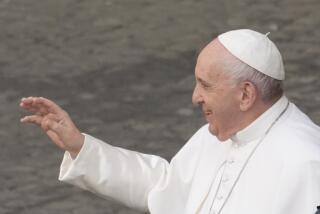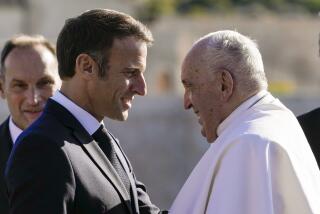Pope, in Oslo, Urges Unity of Christians
- Share via
OSLO — On a pilgrimage far from the madding crowds, Pope John Paul II ventured into a Nordic Europe of few Roman Catholics and empty churches here Thursday with an appeal for unity between historic Christian rivals.
“I have been received no longer as an outsider or a rival, but as a brother in Christ, and for this, I rejoice greatly,” the 69-year-old pontiff told Lutheran bishops at the start of a 10-day Scandinavian visit that will also take him to Iceland, Finland, Denmark and Sweden.
Not all of the region’s Lutherans share the Pope’s ecumenical spirit, but the papal initiative became historic the instant John Paul stepped into a chill and soggy Norwegian morning after a flight from Rome. Never has a Pope visited these officially Lutheran countries that the Vatican saw for centuries as enemy territory.
Celebrating peace and common Christian roots with the Protestants who followed rebel priest Martin Luther out of the Roman church in the 16th-Century Reformation has equal billing on John Paul’s 42nd foreign trip with his mission to his fellow Catholics.
Welcome in Rain
Scandinavia’s Catholics are mostly immigrants or the children of immigrants from countries as diverse as Vietnam, Poland and Chile. In the five countries combined, there are around 200,000 Catholics--about as many worshipers as there were in St. Peter’s Square last Easter. In spic ‘n’ span Oslo, which is home to about 90% of Norway’s 25,000 Catholics, the Pope’s welcome Thursday in spitting rain was lean but cordial.
“We should all be able to enter into dialogue and respect each others’ points of view as people of good faith,” said welcoming Prime Minister Gro Harlem Brundtland, a graduate of medical school at Harvard University. Dialogue and communication, she told the Pope in English, “are crucial for promoting mutual understanding between people from different cultures, of different religions and ideologies.”
As he traveled through a city of 450,000 that seemed barely to notice his passage, John Paul paid a courtesy visit on Norway’s royal family and celebrated an outdoor Mass in the courtyard of medieval Akershus Castle.
‘Ecumenical Task’
In opening day speeches and homilies, most delivered in English, the Pope sounded themes that he will echo throughout his trip. His visit, he said, “is a confirmation of the Catholic Church’s commitment to the ecumenical task of fostering unity among all Christians.”
Catholicism came to Norway about 1,000 years ago in the Middle Ages, but after Luther, it was banned until 1843. Today, there are only 6,000 native-born Catholics in Norway. The rest are immigrants or their children--20% of them Asians, particularly Filipinos, and former Vietnamese “boat people.”
If Catholics are an accepted minority in Norway today, Lutherans are mostly a non-practicing majority: Only about 5% of the 4.2 million Norwegians are regular churchgoers, according to their government’s figures.
Stressing shared roots and values, John Paul hailed Norway’s open-handedness toward refugees, its defense of human rights, its economic support for the world’s have-not nations and its contributions to U.N. peacekeeping missions.
‘Convincing Witness’
“A thousand years of Christian life have profoundly marked Norwegian society,” the Pope proclaimed. “The challenge facing all Christians in Norway is to bear authentic and convincing witness to the Gospel message which is the root and support of these values.”
The shared heritage of Norwegian Protestants and Catholics, John Paul told Lutheran bishops, is “all the more important today, when the ecumenical movement creates new possibilities and a new hope that unity can one day be restored to the followers of Christ.”
Norway, where the papal visit continues today, is a low-hostility stop for the Pope, but there has been strong opposition in Denmark to both his visit and his ecumenical vision. Welcoming the Pope to an ecumenical meeting here, Andreas Aarflot, the Lutheran bishop of Oslo, honed in on some of the long-lived differences between the two churches.
Aarflot applauded the “many signs indicating that the Roman Catholic Church is breaking away from what many observers and historians would call its isolation and self-sufficiency through centuries. . . . Notwithstanding certain positions that many deplore as regressions, the presence of your holiness in our midst today should be seen as a sign of movement toward improved relationships between our churches.”
Scandinavians, Aarflot told the Pope “look forward to the day when your holiness clearly and unequivocally expresses the recognition of the ecclesiastical character of the Lutheran and other Protestant churches. . . . It is not easy to accept that our relationship with our Catholic brothers and sisters cannot be seen as a church-to-church relationship.”
The Norwegian church leader called for “small but daring steps toward a mutual eucharistic hospitality, and eventually toward interim eucharistic sharing” between the two churches.
John Paul, in his address to the Lutheran bishops, reaffirmed Catholic opposition to a common Eucharist.
“The Catholic position on eucharistic sharing is not meant to offend our partners in dialogue,” the Pope said. “Rather, it is an expression of our deep conviction, rooted in our doctrine and in accordance with ancient practice, that the Eucharist is only to be shared by those in full communion with one another.”
More to Read
Sign up for Essential California
The most important California stories and recommendations in your inbox every morning.
You may occasionally receive promotional content from the Los Angeles Times.













